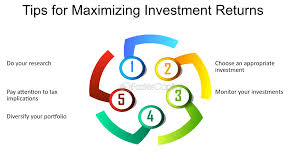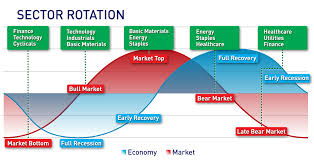Sector rotation, a fundamental concept in investment strategies, refers to the practice of shifting investments between different sectors of the economy to capitalize on their varying performance cycles. This approach is predicated on the belief that economic conditions and business cycles impact different sectors in distinct ways. By strategically rotating investments, investors aim to maximize returns while mitigating risks associated with sector-specific downturns.
Understanding Sector Rotation
Sector rotation is typically driven by macroeconomic factors and the business cycle. The business cycle, which comprises expansion, peak, contraction, and trough phases, influences sector performance. As the economy progresses through these phases, different sectors experience varying levels of growth and profitability.
Expansion Phase: During this phase, the economy experiences increased consumer spending, rising business investments, and overall economic growth. Sectors such as technology, consumer discretionary, and industrials often benefit from these conditions. Technology companies, for instance, tend to see substantial growth as businesses and consumers invest in new innovations and upgrades. Consumer discretionary sectors, including retail and entertainment, also experience higher demand as consumers have more disposable income.
Peak Phase: As the economy reaches its peak, growth rates slow down, and inflationary pressures may build. Sectors that are sensitive to economic cycles, such as materials and industrials, may start to face headwinds. During this phase, investors might consider rotating into sectors that are more resilient to economic slowdowns, such as utilities or healthcare. These sectors often provide stable earnings and dividends, offering a safer investment haven during periods of economic uncertainty.
Contraction Phase: In the contraction phase, economic activity declines, leading to reduced consumer spending and lower business investments. Sectors such as consumer staples, utilities, and healthcare are generally more defensive during this phase. These sectors are less sensitive to economic cycles and tend to maintain stable performance even as the overall economy weakens. Investors may allocate more resources to these defensive sectors to preserve capital and generate consistent returns.
Trough Phase: As the economy hits the trough and begins to recover, early-stage growth sectors such as technology and consumer discretionary often become more attractive. These sectors typically rebound quickly as economic conditions improve and consumer confidence returns. Sector rotation strategies may involve reallocating investments to these growth-oriented sectors to capture the benefits of the economic recovery.
Strategies for Sector Rotation
Several strategies are commonly employed in sector rotation. These strategies are designed to leverage the cyclical nature of sectors and maximize investment returns.
Economic Indicators: Investors often rely on economic indicators to guide sector rotation decisions. Indicators such as GDP growth rates, unemployment figures, inflation data, and interest rates provide insights into the current phase of the business cycle. For example, a rising interest rate environment may prompt investors to shift from interest-sensitive sectors like real estate to more defensive sectors.
Technical Analysis: Technical analysis involves evaluating historical price movements and trading volumes to identify trends and patterns. This approach can help investors gauge the performance of different sectors and make informed rotation decisions. Technical indicators such as moving averages and relative strength indices are commonly used to assess sector performance.
Fundamental Analysis: Fundamental analysis focuses on evaluating the intrinsic value of sectors based on financial metrics such as earnings growth, valuation ratios, and competitive positioning. By analyzing the financial health and growth prospects of sectors, investors can make strategic decisions regarding sector allocation.
Seasonal Trends: Certain sectors exhibit seasonal patterns that can influence investment decisions. For example, the consumer discretionary sector may experience heightened performance during the holiday season, while the energy sector might benefit from seasonal fluctuations in oil prices. Investors may use seasonal trends to time sector rotations and optimize returns.
Risks and Considerations
While sector rotation can be a valuable investment strategy, it is not without risks and considerations. Some of these risks include:
Market Timing: Accurate market timing is challenging, and sector rotation strategies require precise timing to be effective. Incorrectly predicting the transition between economic phases or sector performance can lead to suboptimal investment outcomes.
Sector Overlap: Some sectors may exhibit overlapping characteristics, making it difficult to isolate their performance from broader market trends. For example, technology and consumer discretionary sectors may both be influenced by consumer spending patterns, complicating the rotation process.
Economic Uncertainty: Economic conditions can be unpredictable, and external factors such as geopolitical events, regulatory changes, and global economic developments can impact sector performance. Investors should be prepared for unexpected shifts in the economic landscape.
Diversification: Overemphasis on sector rotation may lead to reduced diversification within an investment portfolio. It is essential to balance sector-specific investments with overall portfolio diversification to manage risk effectively.
Maximizing Returns by Investing in Trending Industries

In the modern investment landscape, maximizing returns is often sought through investments in trending industries. The potential for high returns has been recognized as trends in various sectors capture the interest of investors worldwide. When these industries are identified and evaluated, significant opportunities for growth and profitability are frequently discovered.
The first step in this process involves the identification of trending industries. Observations are made regarding sectors that are experiencing rapid growth or have shown consistent upward trajectories. Market research reports, financial news, and economic forecasts are typically consulted to determine which industries are currently trending. Such research often reveals industries driven by technological advancements, consumer preferences, or shifts in economic conditions.
Once the trending industries are identified, investors are advised to conduct thorough due diligence. This involves analyzing the underlying factors contributing to the industry’s growth. Key performance indicators, market size, and competitive landscapes are examined. Financial statements of leading companies within the industry are reviewed to assess their profitability and financial health. The stability and sustainability of the industry are also evaluated to determine whether the growth trend is likely to continue.
Investment strategies are then formulated based on the findings of the due diligence process. Diversification is often recommended to mitigate risks. Investments are spread across different companies within the trending industry, or even across several trending industries, to reduce exposure to any single investment’s potential downturn. Additionally, various investment vehicles, such as stocks, bonds, and mutual funds, are considered to align with the investor’s risk tolerance and investment goals.
In the context of emerging technologies, industries such as artificial intelligence, renewable energy, and biotechnology are frequently highlighted. The rapid advancements and increasing applications of these technologies have led to significant investment opportunities. Companies developing innovative solutions or improving existing technologies are often targeted for investment. The growth potential of these companies is assessed based on their research and development capabilities, intellectual property, and market demand.
Consumer-driven trends are also influential in investment decisions. Industries related to health and wellness, e-commerce, and entertainment have been observed to benefit from changing consumer preferences. As lifestyles and consumer behaviors evolve, businesses that cater to these new demands are likely to experience growth. Investments in companies that are well-positioned to capitalize on these trends can result in substantial returns.
Economic factors play a crucial role in the performance of trending industries. Macroeconomic indicators, such as interest rates, inflation, and economic growth rates, can impact the profitability of investments. The broader economic environment is analyzed to understand how it may influence the performance of the trending industries. For example, during periods of economic expansion, consumer spending tends to increase, which can benefit industries related to retail and leisure.
In addition to economic factors, geopolitical events and regulatory changes can affect trending industries. Trade policies, environmental regulations, and political stability are some of the factors that can influence industry performance. Investors are encouraged to stay informed about these factors and assess their potential impact on their investments.
Long-term trends are also considered in the investment decision-making process. Industries that are expected to grow over the long term are often prioritized over those with short-term fluctuations. By focusing on industries with strong growth prospects, investors aim to achieve sustainable returns. Long-term investments are typically evaluated based on their potential to deliver consistent performance over an extended period.
Monitoring and adjusting investment portfolios is an ongoing process. As industries evolve and new trends emerge, it is essential to reassess investment strategies. Regular reviews of investment performance and market conditions are conducted to ensure that the portfolio remains aligned with the investor’s objectives. Adjustments are made as needed to capitalize on new opportunities or address any emerging risks.
The role of technological advancements in shaping investment strategies cannot be overlooked. With the rise of digital tools and platforms, investors have access to a wealth of information and analytical capabilities. Data-driven insights and automated trading systems are increasingly used to enhance investment decisions. These technologies enable investors to identify trends more efficiently and make informed decisions based on real-time data.
In conclusion, maximizing returns by investing in trending industries requires a strategic approach. Identifying trending industries through comprehensive research, conducting due diligence, and formulating investment strategies are critical steps in the process. Economic factors, consumer preferences, and technological advancements all play significant roles in shaping investment opportunities. By staying informed and adapting investment strategies to evolving trends, investors can position themselves to achieve optimal returns.
Conclusion
Sector rotation represents a strategic approach to investing that seeks to capitalize on the cyclical nature of economic conditions and sector performance. By shifting investments between sectors based on macroeconomic factors and business cycle phases, investors aim to enhance returns and mitigate risks. While sector rotation can offer significant advantages, it is important to consider the associated risks and employ a well-rounded investment strategy. Understanding the underlying economic dynamics and utilizing various analytical tools can help investors make informed decisions and optimize their investment outcomes.










